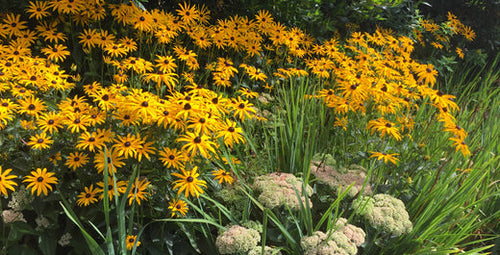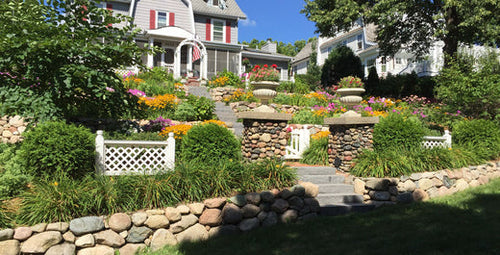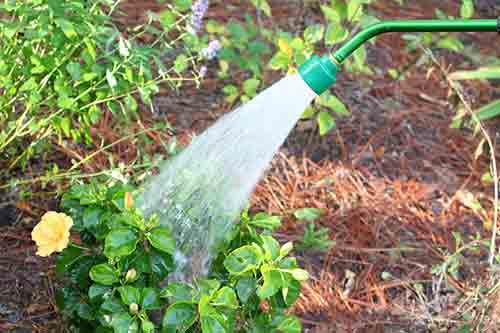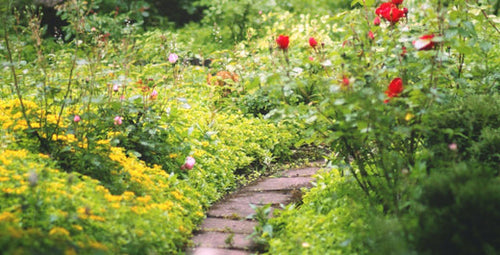By Doug Jimerson
Mixing and matching colorful flowers in your beds, borders, and containers is a lot of fun, but can also be a bit overwhelming when you first walk into a well-stocked garden center. Colorful plants and flowers scream for attention from every corner, making it a bit hard to focus on what plants look best together.
So do what the professionals do: create a list of plants based on their color, growth habit, and light requirements. Tuck your list into your pocket when you go plant shopping. It helps focus you on your gardening goals and minimizes the chances that you’ll end up grabbing whatever looks pretty at that moment, but doesn’t really go with anything else once you get home.
The smart thing to do is to plan early, selecting the color palette you want to have for a particular container or your whole garden. Here are some tips on selecting flowers of different colors to create a professional looking garden or container.

Red in the Garden
If you want to make a bold statement, red flowers are the way to go. There’s nothing subtle about a garden packed with fiery red flowers. Plants with red-flowering varieties include hibiscus, canna, salvia, mandevilla, and geranium--all these flowers love full sun, so they can be mixed and matched. Begonias and coleus can turn on partially shaded areas. At left, a hot bed of red begonia and coleus chills out with a frame of silver dusty miller.
PRO TIP: An all-red garden can be overpowering, so add some pale yellow or white accent plants will help cool things down.
Blue and Purple in the Garden
Plants with blue or purple flowers blend wonderfully with almost any other color, particularly those with white, yellow, or pink blooms. Blue and purple blooms bring cool, soothing color to beds and borders. Some top picks include: ageratum, delphinium, perennial geranium, catmint, heliotrope, agapanthus, and scaevola.
PRO TIP: Blue flowers have a tendency to disappear when viewed from a distance so keep them up close in beds and containers where you can enjoy their cooling hues.

Yellow in the Garden
For a sunny, cheerful look, you can’t go wrong with yellow flowers. They work well with almost any other hue and come in so many different shades, so it’s easy to find complementary partners. At left, for example, a bed of yellow zinnias with purple verbena accents brightens a garden path. Other good yellow bloomers include: marigold, coreopsis, black-eyed Susan, snapdragon, pansy, and daylily.
PRO TIP: Round flower heads, such as zinnias, marigolds, and black-eyed Susan, offer a mass of yellow color. To add spikes of yellow to your garden or container, use snapdragons or daylilies.
Orange in the Garden
A lot of gardeners have a hard time using orange in the garden, because it’s such a strong color. But, if paired with blue or yellow flowers, you can create amazing combinations in your garden. Reliable orange flowers include: calendula, butterfly weed, gazania, and lily.
PRO TIP: Think of the seasonality of bloom when planting. Enjoy orange flowers in your garden from spring to fall. In spring, plant orange pansies. In summer, replace pansies with tithonia, marigolds, lilies, and gazania, and add orange mums to your garden in autumn.
White in the Garden
Always include a generous selection of white flowers in your containers and garden beds. They provide a frothy, cool contrast to brighter blooms and look great in all seasons. Some top white bloomers include: sweet alyssum, petunia, candytuft, jasmine, euphorbia, and Nippon daisy.
PRO TIP: Cool off hot beds of color a refreshing white edge. Another benefit of white flowers is that you can see them at dusk as they add glowy ambiance to patios and walkways.

Pink in the Garden
Pink flowers make terrific partners for blue, white, or yellow bloomers. Some favorite pink flowers include: cosmos, bleeding heart, peony, dianthus, and coneflower. In the mixed border at left, pink coneflower holds court over a legion of blue and white annuals and perennials.
PRO TIP: Pink flowers offer a wide range of hues--from soft pastels to stronger vibrant fuchsia. Pink is a favorite color in cottage gardens.

















